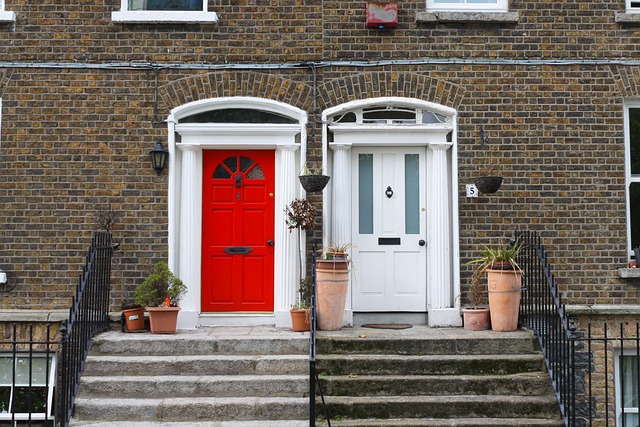In an inclusive society, accessible door solutions are essential for guaranteeing equal entry for everyone, regardless of physical ability. These include sliding doors and automatic doors that simplify access for disabled people. Businesses can meet diverse visitor needs, comply with accessibility standards, and showcase their commitment to inclusivity by adopting these solutions. With various designs available, from classic swinging doors to modern automatics, these solutions offer both functionality and aesthetics. Key design considerations like width, lever handles, hands-free access, and clear space enhance inclusivity. Implementing a range of accessible door solutions benefits users with mobility impairments while allowing design flexibility for architects. Future innovations include smart technology integration and customizable designs, promising enhanced functionality and aesthetics.
In today’s inclusive design landscape, accessible door solutions are no longer an option—they’re essential. From sliding doors that offer smooth transitions for wheelchairs to swinging doors accommodating various mobility aids, and automatic doors providing hands-free entry, these options enhance functionality and accessibility. This article explores the significance of diverse accessible door styles, delves into popular types, provides design considerations, highlights benefits, and peers into future trends shaping this vital component of our built environment.
Understanding the Importance of Accessible Door Solutions
In today’s diverse and inclusive world, understanding the importance of accessible door solutions is paramount. These solutions go beyond mere convenience; they are essential for ensuring equal access and navigation for individuals with various physical abilities and disabilities. From sliding doors that offer smooth, barrier-free entry to automatic doors that eliminate the need for manual operation, each design choice plays a crucial role in fostering an environment where everyone feels welcome and able to move freely.
By implementing accessible door solutions, businesses, and properties can cater to a broader range of visitors, including those using wheelchairs, mobility aids, or with visual or motor impairments. This not only enhances the user experience but also complies with accessibility standards and regulations, demonstrating a commitment to inclusivity and social responsibility. In terms of design, these doors are available in a wide selection of styles—from classic swinging doors to modern sliding and automatic options—allowing for both functionality and aesthetic integration into any space.
Types of Accessible Doors: Sliding, Swinging, and Automatic
In the realm of accessible door solutions, a wide array of options cater to diverse needs and preferences. Among these, sliding doors offer a seamless and space-saving approach, ideal for narrow passages or areas requiring maximum accessibility. Their smooth, horizontal motion allows for easy navigation, making them particularly beneficial for individuals using wheelchairs or mobility aids.
Swinging doors, on the other hand, provide a classic and elegant solution, opening outward to create a welcoming entrance. These doors are versatile and can be tailored to various styles, offering both functionality and aesthetic appeal. Automatic doors represent another cutting-edge accessible door solution, employing sensors to facilitate hands-free operation. This feature not only enhances accessibility but also promotes hygiene, making them perfect for high-traffic areas or places where maintaining cleanliness is paramount.
Design Considerations for Accessible Doorways
When designing accessible doorway solutions, several key considerations come into play to ensure inclusivity and ease of use for all individuals, including those with disabilities. One of the primary focus points is width—doorways should be wide enough to accommodate wheelchairs, mobility scooters, and other assistive devices, typically a minimum of 900mm (36 inches) for single doorways and 2000mm (78 inches) for double doorways.
Door hardware and operation also play crucial roles. Lever handles are preferable over knobs to reduce hand strain, while automatic sliding or swinging doors provide hands-free access, significantly improving accessibility. Additionally, clear space around the doorway, free from obstacles, allows for unobstructed entry and exit. These design considerations collectively contribute to creating inclusive spaces that cater to the diverse needs of all users.
Benefits of Implementing Diverse Door Options
Implementing a wide selection of accessible door solutions offers numerous benefits, both functional and aesthetic. By providing diverse options like sliding, swinging, and automatic doors, buildings can better accommodate a variety of user needs, including those with mobility impairments or other physical limitations. This inclusivity enhances accessibility and ensures everyone feels welcome and comfortable within the space.
Moreover, offering a range of door styles allows for enhanced design flexibility and customization. Building managers and architects can select doors that complement their overall aesthetic vision while meeting the essential requirements for accessibility. Such adaptability not only improves the user experience but also contributes to creating an environment that is visually appealing and welcoming for all visitors.
Future Trends in Accessible Door Technologies
The future of accessible door solutions looks bright, with continuous innovations aimed at enhancing both functionality and aesthetics. One prominent trend is the integration of smart technology, enabling doors to communicate with users through voice commands, mobile apps, or automated systems. This not only improves convenience but also makes them more inclusive for individuals with diverse abilities. For instance, automatic sliding doors equipped with sensors can detect proximity, opening seamlessly for wheelchair users or people with reduced mobility.
Additionally, there’s a growing focus on customizable designs that blend seamlessly into modern architecture while still adhering to accessibility standards. Bespoke door styles, including minimalist panels and elegant frames, are being developed to cater to various interior themes without compromising accessibility features. These future trends promise to create a seamless transition between spaces, ensuring comfort and ease of access for all.
In conclusion, the wide array of accessible door styles, from sliding and swinging to automatic options, offers versatile solutions for enhancing inclusivity. By considering design aspects and reaping benefits like improved accessibility and user experience, buildings can become more welcoming for all visitors. Furthermore, staying informed about emerging trends in accessible door technologies ensures a future where navigation is seamless and barrier-free for everyone. Implementing diverse door options truly revolutionizes the way we approach building design and accessibility.
